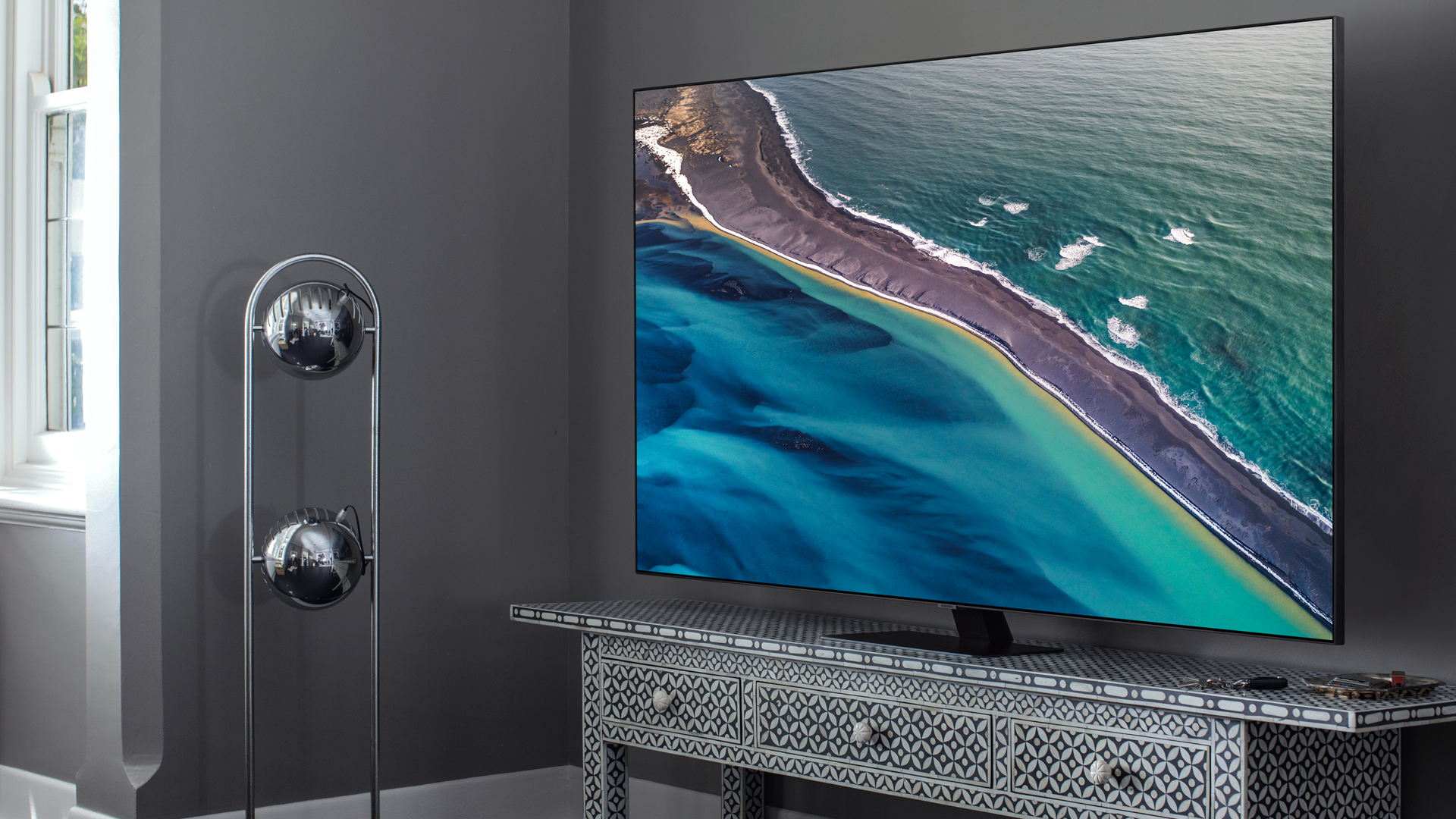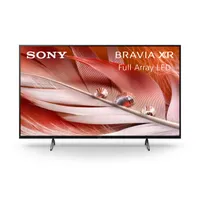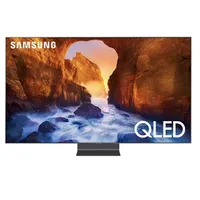TechRadar Verdict
The Samsung Q80T QLED TV is a premium-priced, mid-range QLED that barely puts a pedestal wrong. It offers vibrant HDR, a forward-facing feature set and HD upscaling to die for.
Pros
- +
AI-enhanced 4K Quantum image processor
- +
Ultra-low image lag
- +
Superior OTS sound
Cons
- -
No Dolby Vision
- -
No Freeview Play
- -
Not the prettiest QLED you can buy
Why you can trust TechRadar
The Samsung Q80T QLED TV is an excellent jumping-on point if you want one of the cheapest full array backlight QLED TVs in the Samsung TV range.
When it came out in 2020, it was strategically positioned just below the Q90T, with which it shares a number of advanced features, and above the edge-lit Q70T. Which means the Q80T sits comfortably in the mid-range, but its performance is far from average.
We still highly rate the Samsung Q80T QLED TV even though it's a few years old, but it has been usurped by newer models in our best Samsung TV guide and our best TV guide.
We tested the QE65Q80T (the 65-inch size) and found it had bright peaky HDR, gorgeous definition and a wide color gamut. Make no mistake: the Samsung Q80T QLED TV looks every bit as pretty as you’d hope—while packing some surprising extras to boot. Read our full Samsung Q80T QLED review below to find out more.
Samsung Q80T QLED review: price and availability
- Released in 2020, so might be hard to find
- Available in 49, 55, 75 and 85-inch sizes
The Samsung Q80T QLED TV launched in 2020 in 49-inch, 55-inch, 75-inch and 85-inch models.
Screen type: QLED
Sizes: 49, 55, 75 and 85-inches
Resolution: 4K, 3,840 x 2,160
HDMI: 4
Dolby Audio: Dolby Digital, Dolby Digital Plus
HDR formats: HDR10, HDR10+, HLG
Video formats: MPEG4/2, HEVC, VP9
Video processor: Quantum Processor 4K
Prices began at $1,349 / £1,279 / around AU$1,809 but they've since been reduced. In fact, a few size options now seem to be discounted on the Samsung website, and through many third-party retailers.
For a slightly pricier option, the step up from the Q80T at the time of launch was the Q90T, which you can read more about in our Samsung Q90T QLED TV review. Or take a look at the step down in our Samsung Q70T QLED TV review, which starts at £1,099 / $999.
Sign up for breaking news, reviews, opinion, top tech deals, and more.
Since launch, the Q80T has had several successors, including the Q80A in 2021, a 55-inch model available from $1,299 / £939 / AU$1,749.
The Q80T is significantly cheaper than Samsung's newer range of Neo QLED models, check out our Samsung QN90A Neo QLED TV review for a thin, bright and bold 2021 TV that costs $1,499 / £1,799 for the 50-inch model.
Samsung Q80T QLED review: design
- Not the slimmest TV
- Four HDMI ports
It’s inevitable that the Samsung Q80T QLED TV, which features a FALD (Full Array Local Dimming) backlight, is not going to be the slimmest flatscreen on the shelves, but for most buyers the extra bulk is going to be worth it.
Samsung’s designers have gone some way to mitigating this extra depth by framing the panel with a ridiculously minimal bezel, creating the illusion that pictures are magically hanging in the air.
Connectivity is excellent, too, with four HDMIs that offer advanced and varying specifications. There’s 4K at 120fps support on HDMI 4, and eARC on input 3.
The set can handle 4K at 60Hz (expected from PlayStation 5 and Xbox Series X games), 2K at 120Hz, plus VRR (Variable Refresh rate) and ALLM (Auto Low Latency Mode). FreeSync support is included for PC AMD gamers too.
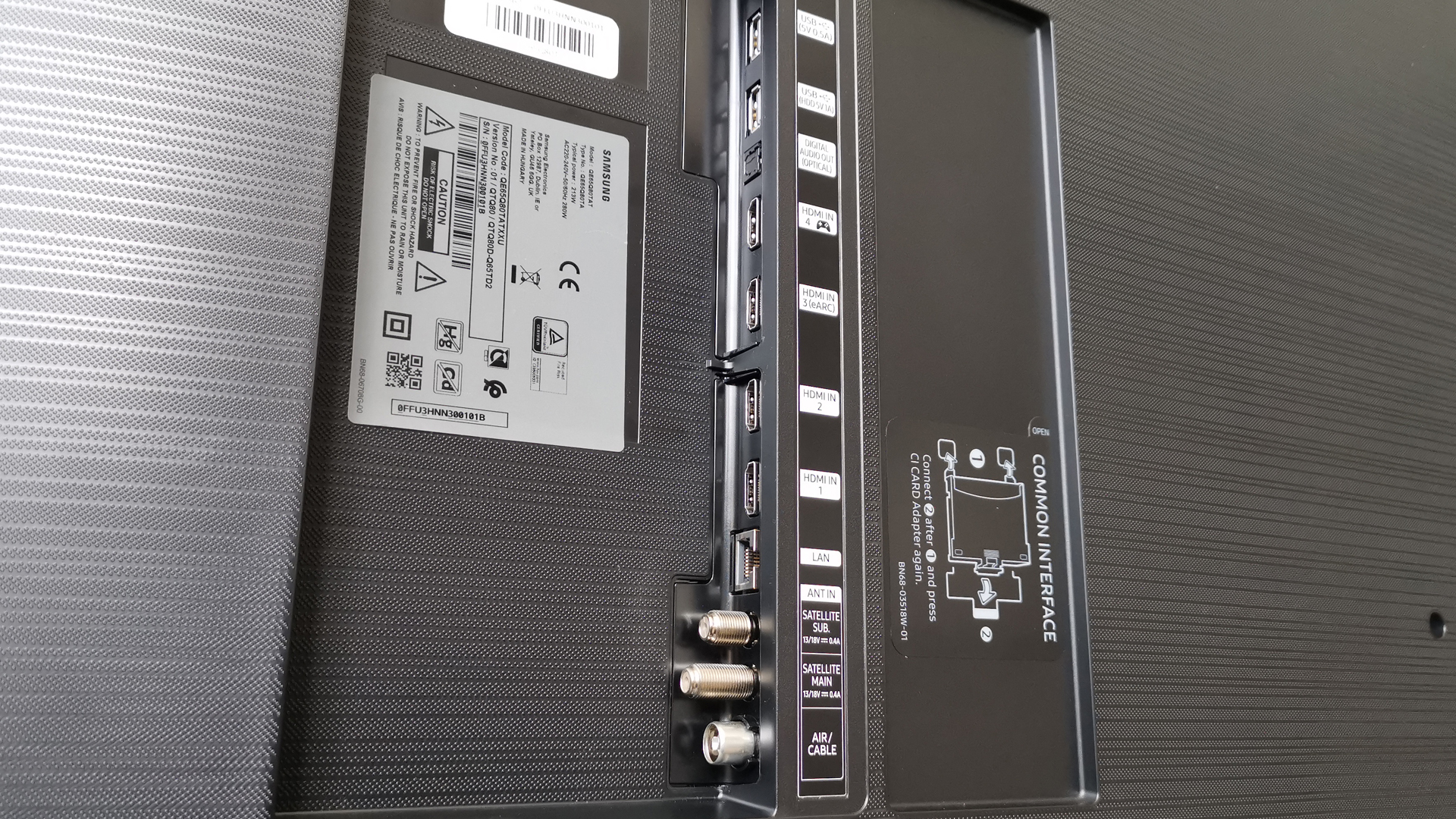
Rounding things out are two USB ports, digital optical audio out, Ethernet to support Wi-Fi and Bluetooth, and a Common Interface slot, for all those territories which require one. You almost certainly won’t need everything on offer, but it’s nice to have them in reserve.
The screen is bundled with two remote controls, one the usual button strewn offering most of us will gravitate to, the other a simplified pointer.
Samsung Q80T QLED review: smart TV (Tizen)
- Lots of streaming apps
- Multi View Mode will be appealing for some
Samsung made revisions to its Tizen smart TV platform in 2020 to improve usability. The launcher bar is a little smaller, allowing more apps to sit onscreen without a need to scroll. When viewed on the larger Q80T models, this makes perfect sense. There’s also enhanced connected device discovery, making it easier to jump between inputs.
Also new this season is Mobile Multi View with Casting, which enables two screens (the main TV image and your smartphone) to be watched simultaneously.
While there’s no Freeview Play tuner (on the UK edition of the set), all key Catch-up TV channels are supported, along with Netflix, Amazon Prime Video, Disney Plus, Rakuten TV, Apple TV and YouTube (to name but a few).
Samsung’s Ambient mode also makes a welcome return, allowing the QLED screen to serve as a gallery for JPEGs or artworks, or double as a news ticker or clock.

Samsung Q80T QLED review: HD/SDR performance
- HD SDR upscaling is best in class
- Motion handling is good
Normally, it’s 4K HDR performance that steals all the headlines in a TV review. But that’s not entirely the case here. Thanks to the set’s UHD Quantum image processor, which has trickled down from Samsung’s 8K flagships, and some new AI smarts, the Q80T’s performance with HD SDR content is a real showstopper.
The TV is able to interpolate subtle elements of detail into HD and lower resolution content, creating a compelling UHD-style image. The processor works out what is native detail, and then through comparison with a texture database, creates more of the same.
Not only is this talent a godsend in these bit-reduced times, but it also breathes new life (actually interpolates detail) into any non-UHD disc collection.
SDR picture modes comprise Standard, Dynamic, Natural and Movie. Standard and Natural work with most content types, with the latter having the edge in brighter viewing rooms, where its tendency to crush black level detail in order to enhance contrast is less obvious.
The Dynamic mode leads to quite oversaturated images, though, while Movie basically does the exact opposite.

If you don’t want to faff around in menus, and can’t persuade other household members to manipulate image presets, there’s an updated version of the brand’s Intelligent Mode, with adaptive brightness and adaptive sound, that’ll make the most of incoming content.
Motion handling is above average, too, so this a good screen for lovers of sport (where you can find it).
Auto Motion Plus settings can be manually configured, with adjustable blur and judder reduction. If you don’t want things to look overly processed, keep blur reduction low and judder reduction at around 4. Alternatively, leave the system on Auto.
Of course, if you really want to let the Q80T’s 4K Quantum processor off the chain, feed it some native UHD. It boasts a raft of technologies able to maximise colour, detail and specular highlights.
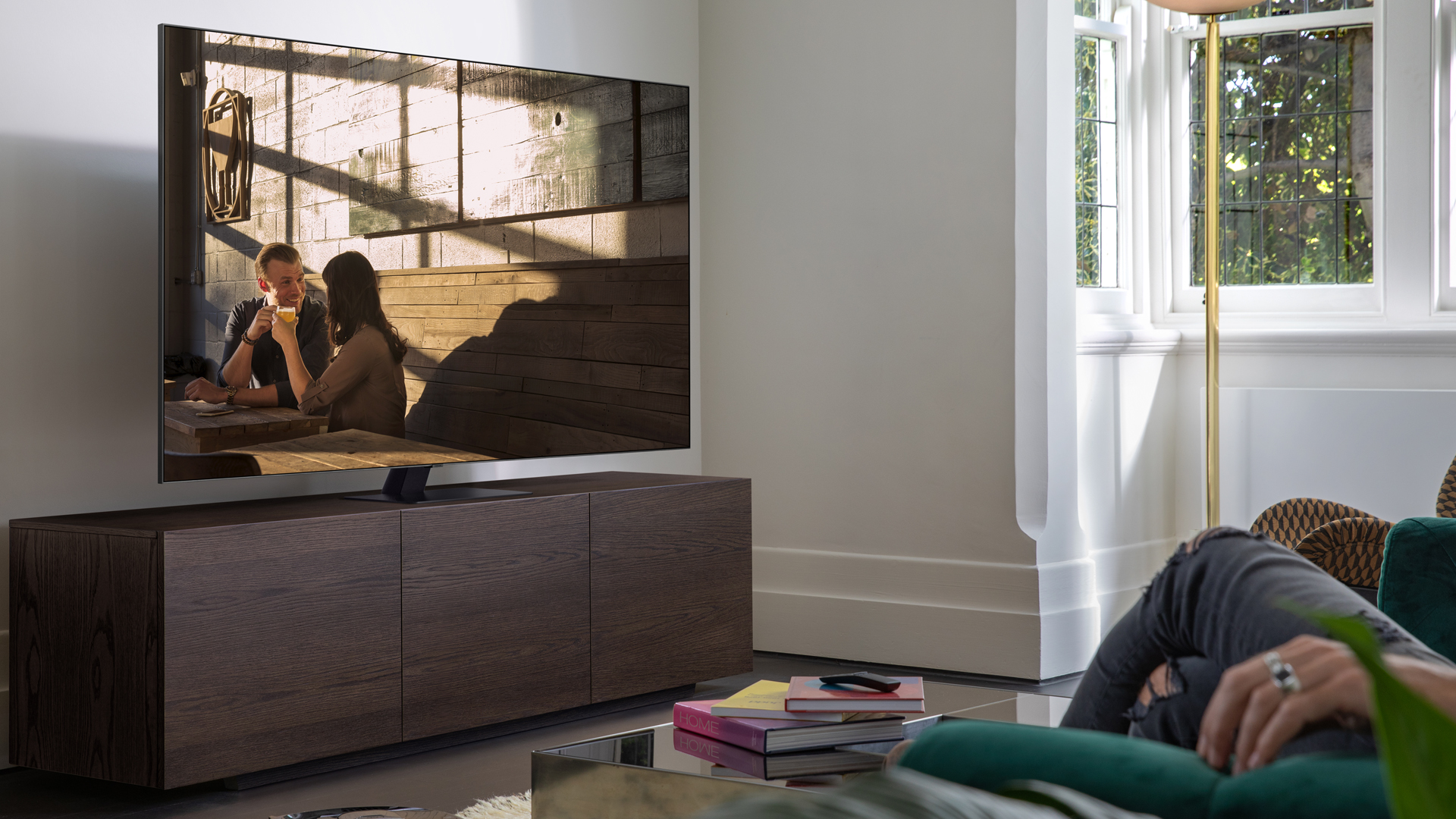
Samsung Q80T QLED review: 4K/HDR performance
- Fewer dimming zones than 2019's Q80R model
- Super definition and rich color
Although it’s tempting to compare the Q80T with 2019’s Q80R, this model is actually an update on 2019’s Q70R. (Confused? That’s probably the idea). The Q80T shares the same number of backlight zones as the Q70R (around 50). This puts it some way behind FALD flagships, but it’s still good enough to offer more HDR precision when compared to edge-lit screens, all while maintaining decent screen uniformity.
For the most part, you won’t notice errant screen blooming, except on dark scenes with bright highlights. More often than not, the giveaway is black letterbox bars with movies.
When something bright moves into the space just above or below the picture area, you’ll see some light pollution – but the effect is relatively fleeting.
The set’s overall HDR performance is strong, too. We measured peak brightness just under 900 cd/m (aka nits), using a 10 percent HDR window.
This range covers most commercially produced HDR content, and presents bright highlights that add sparkle and depth to images.
Infuriatingly, though, there’s no support for Dolby Vision. Samsung maintains it doesn’t need it, although its reticence to embrace what is a universal dynamic metadata standard appears more political than practical.
On the plus side, there is provision for HDR10+—used by Amazon Prime in place of Dolby Vision—as well as static HDR10 and broadcast standard HLG.
Samsung Q80T QLED review: sound and gaming
- Solid sound, high and wide soundstage
- Game Motion Plus with blur, judder reduction and more
While the Q80T looks fairly conservative, it actually boasts a rather radical sound system. Rather than just relying on downward firing stereo drivers, Samsung’s designers have added a second pair at the top left and right of the display.
This enables the screen to produce a soundstage that’s both high and wide. We’re not talking Dolby Atmos immersion—although if you want to bitstream that out over HDMI to a waiting soundbar or home cinema system, you can—but we are talking about an impressive wall of noise.
The implementation dovetails with the brand’s OTS (Object Tracking Sound) audio system, which adds a level of directionality to movement on screen. Dialogue locks to the centre of the picture, while stereo pans enjoy an enhanced sense of spatial movement.
Total audio output is rated at 60W, more than enough for the average movie night. The audio quality itself is mid-fi at best, but the end result remains entirely satisfying.

Stressing the Q80T’s credentials as a gaming display are some truly impressive low latency figures—though one consequence of chasing the lowest possible image lag is a deterioration in image quality. When you turn off all the processing in a panel, you’re sacrificing a lot of the good stuff.
That’s why Samsung offers a dedicated Game Motion Plus, which includes blur and judder reduction, plus optional LED clear motion. Even with this processing suite engaged, input lag is an admirably low 19.7 milliseconds (1080/60). For truly competitive players, this can be switched off, dropping image lag to just 8.7ms. Lag that low is truly remarkable for a consumer TV.
Of course, if you spend most of your time playing Animal Crossing, we advise sticking to the Standard image preset, and enjoying the picture dividends that brings.
Conclusion
The Samsung Q80T gets just about everything it sets out to do right.
Unusually for such a premium set, it’s not specifically tailored for the home cinema crowd, courting gamers and mainstream viewers instead—but this is probably a smart move, not least because the lack of Dolby Vision won’t stick in the craw of that designated audience.
Good contrast and vibrant colour, coupled to sensational upscaling and advanced smart features like Ambient mode, ensure the Q80T warrants frontrunner status.
It was released in 2020, which means you might not find it in stock in some retailers. But now it's a few years old you could pick it up for a discounted price—which would still make it excellent value.
Also consider...
If our Samsung Q80T QLED review has you considering other TV options, then here are three more mid-range TV sets that are worth checking out.
Sony X90J
There are similarities between the Samsung Q80T and the Sony X90J we're reviewing here. You'll find better brightness and contrast with the X90J, which means it might be better suited for movie lovers. Although if you're into gaming, stick with the Q80T as it has lower input lag and faster response times.
Read our full Sony X90J review
Samsung Q90 QLED TV
If you're looking for a boost in performance, get the Q09 rather than the Q80T. It has higher brightness at its peak and a higher contrast ratio, too. It was also released in 2020, so although it might be hard to find, if it's discounted it's a solid choice.
Read our full Samsung Q90 QLED TV review
Samsung QN90A Neo QLED TV
For a newer Samsung option with better performance check out the QN90A Neo QLED TV. This is one of the brand's Mini LED TVs so it gets brighter and has improved local dimming. So it would be a step up for movie lovers and gamers alike, although it is more expensive, but that's to be expected for a newer model like this one.
Read our full Samsung QN90A Neo QLED TV review
- First reviewed in May 2020.
- Get the best deal on Samsung products with our Samsung promo codes.

Steve has been writing about AV and home cinema since the dawn of time, or more accurately, since the glory days of VHS and Betamax. He has strong opinions on the latest TV technology, Hi-Fi and Blu-ray/media players, and likes nothing better than to crank up his ludicrously powerful home theatre system to binge-watch TV shows.
